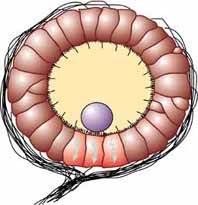
Back Статоциста Bulgarian Statocysta Czech Statocyste German Statocyst English Estatocisto Spanish ترازکیسه Persian Statocyste French Estatocisto Galician Statocisti Italian სტატოცისტები Georgian

Els estatocists són els òrgans de l'equilibri d'invertebrats com els mol·luscs,[1] bivalves,[2] cnidaris,[3] equinoderms,[4] cefalòpodes,[5] i crustacis.[6] Una estructura similar es troba als Xenoturbella.[7]
Tenen una estructura en forma de sac, amb un epiteli de cèl·lules ciliades, líquid i estatòlits en el seu interior. Aquests darrers són masses calcàries que quan es desplacen pergravetat i el mateix moviment de l'animal, pressionen sobre l'epiteli ciliat, el qual mitjançant connexions nervioses, envia la informació al centre elaborador de la posició en la que es trobi.
El seu equivalent en els vertebrats correspon als otòlits, ubicats en l'oïda interna, per la qual cosa en els vertebrats és un sistema estato-acústic.
- ↑ Levi, R.; Varona, P.; Arshavsky, Y. I.; Rabinovich, M. I.; Selverston, A. I. «Dual Sensory-Motor Function for a Molluskan Statocyst Network». Journal of Neurophysiology, 91, 1, 2004, pàg. 336-345. DOI: 10.1152/jn.00753.2003.
- ↑ Morton, B. «Statocyst structure in the Anomalodesmata (Bivalvia)». Journal of Zoology, 206, 2009, pàg. 23–34. DOI: 10.1111/j.1469-7998.1985.tb05633.x.
- ↑ Spangenberg, D. B. «Statolith formation in Cnidaria: effects of cadmium on Aurelia statoliths». Scan Electron Microsc, 4, 1986, pàg. 1609-18. PMID: 11539690.
- ↑ Ehlers, Ulrich «Ultrastructure of the Statocysts in the Apodous Sea Cucumber Leptosynapta inhaerens (Holothuroidea, Echinodermata)». Acta Zoologica, 78, 1, 1997, pàg. 61-68. DOI: 10.1111/j.1463-6395.1997.tb01127.x.
- ↑ Clarke, Malcolm R. «The cephalopod statolithan-introduction to its form». Cambridge University Press, 58, 3, 11-05-2009. DOI: 10.1017/S0025315400041345.
- ↑ Cohen, M. J. «The response patterns of single receptors in the crustacean statocyst». Proceedings of the Royal Society B: Biological Sciences, 152, 946, 1960, pàg. 30–49. DOI: 10.1098/rspb.1960.0020. PMID: 13849418.
- ↑ Israelsson, O. «Ultrastructural aspects of the 'statocyst' of Xenoturbella (Deuterostomia) cast doubt on its function as a georeceptor». Tissue and Cell, 39, 3, 2007, pàg. 171–177. DOI: 10.1016/j.tice.2007.03.002. PMID: 17434196.